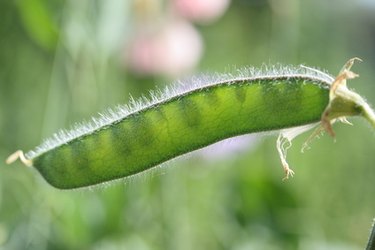
In the mid- to late 19th century, scientists struggled to understand fully the specifics of genetics. A relatively unknown teacher and monk, Gregor Mendel, published a study of pea plants in 1866. In his study, Mendel proposed that genetic traits are dominant and recessive and that they can skip generations. Though his findings went unnoticed at the time, Mendel's study on dominant and recessive pea plant traits are now considered pioneering.
Seedpod Color
Video of the Day
The most often cited of Mendel's genetic experiments with pea pods involves the color of the seedpods. Seedpods on pea plants are either yellow or green. Yellow seedpods are genetically recessive. Green seedpods are genetically dominant. Mendel discovered that no yellow seedpods were present in the offspring of crossbred green pod and yellow pod plants. Mendel further discovered, however, that second generation offspring will be 1/4 yellow, and 3/4 green. Thus, while green seedpods are dominant and yellow seedpods are recessive, the recessive lineage does not disappear completely.
Video of the Day
Flower Color
Another of Mendel's experiments with pea plants involved the color of their flowers. Pea plant flowers are either white or purple. Through breeding of multiple generations of pea plants, Mendel discovered that purple flowers are dominant and white flowers are recessive. The Principle of Segregation proposed by Mendel stipulates that each parent has two alleles, or genetic encoders, for each trait, and that one of these alleles passes from each parent to offspring. Thus, if two pea plants are bred, white flowers will be present in offspring only if both parents pass on a white flower allele.
Flower Position
The placement of the flowers of a pea plant is determined genetically. A flower has two possible positions on a pea plant, terminal and axial. Terminal flowers grow at the end of the plant stem. Axial flowers grow near the middle of the plant. As per Mendel's findings, axially positioned flowers are dominant in pea plants, and terminally positioned flowers are recessive. Thus, a purple flower in the axial position is a doubly dominant trait in pea plants, and a white flower in the terminal position is a doubly recessive trait.
Other Characteristics
Mendel studied a total of seven traits in pea plants. In addition to seedpod color, flower color and flower position, the geneticist looked at the texture of seeds, seed albumen, the length of the plant stem and the form of ripe pea pods. As per Mendel's findings, smooth peas are dominant texturally, and wrinkled pods are recessive. A yellow seed albumen is dominant, and a green seed albumen is recessive. Tall stems are dominant, and dwarf, or short, stems are recessive. Finally, Mendel found inflated form pods to be dominant and restricted form pods to be recessive.